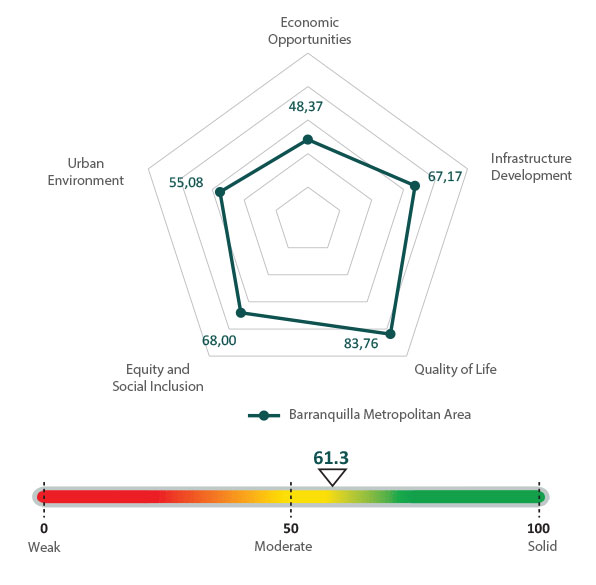
According to a reading of the levels of territorial prosperity in the city of Barranquilla, developed on the basis of the indicators of the Urban Prosperity Index (CPI), The prosperity values reach a solid moderate value with 61.3 points out of 100 points. The main strengths in terms of territorial prosperity and potential for population integration are related to the health and education systems that present solid conditions to meet the demands of the population despite the existing territorial gaps in terms of accessibility considering the deficit of equipment coverage in the neighborhoods of lower socioeconomic strata. In terms of social support infrastructure, there is almost 100% coverage of basic service networks (improved water, sanitation and electricity), while housing conditions are solid in most of the territory (85% of homes classified as adequate housing). These conditions show that the territory has the capacity to respond adequately to the demands of the population.
* These indicators include: life expectancy at birth, under-five mortality rate, vaccination coverage, maternal mortality, literacy rate, average years of schooling (disaggregated between males and females), attendance of children under 6 years of age in early childhood development programs, net higher education rate.

The results of these indicators show that one of the main challenges for prosperity is the residential densification of the metropolitan area, with high levels of density in the south of the city, where the lowest economic strata are located, and low levels of density in the north, where the highest strata are concentrated. Likewise, in terms of connectivity, the unequal distribution of internet access (58% of all households have access to fixed internet) points to a challenge for the city’s population in the future. Finally, the city’s design promotes adequate conditions for pedestrian and non-motorized connectivity; however, the edges of the city and some areas in the center present interconnection and road density challenges that make walking more difficult.
Results of infrastructure for development measure: 67.17 / 100
The results of these indicators indicate that, among the main challenges for the prosperity of Barranquilla, it is necessary, on the one hand, to reduce the unequal distribution of common goods in spatial terms, which includes the distribution of health, education, culture, recreation and public spaces that are located outside a radius of accessibility for households in greater socioeconomic and territorial vulnerability. On the other hand, there are conditions of insecurity that impact the quality of life of its inhabitants, with greater recurrence in the southern districts of the city. Despite this, the quality of life dimension presents adequate values in Barranquilla in strategic indicators such as life expectancy at birth (75.85 years / 85 years ideal value) and infant mortality (2.63 per 100,000 live births). In education, the average literacy rate is 96.59% of the population with an average of 11.83 years of schooling (without varying significantly between men -11.89 years- and women -11.77 years-).
Results of quality of life measurement: 83.76 / 100


The results of these indicators show that, in environmental matters, the main challenge for the promotion of territorial prosperity is the implementation of existing policies for the management and protection of natural resources, which allows improving the environmental condition of the municipality.
Results of urban environment measurement: 55.08 /100
The results of these indicators show that one of the main challenges for territorial prosperity is access to adequate employment opportunities and social security to reduce social gaps, monetary poverty rates and unsatisfied basic needs, and promote access to adequate quality of life.
Results of economic opportunities measurement: 48.32 / 100


The results of these indicators show fragmentation of the territory in terms of access to employment, health, education and cultural opportunities, which impacts the population of lower socioeconomic strata and greater territorial vulnerability. This indicates that households with lower economic resources are concentrated in the neighborhoods of the western periphery, while in the center (where there is greater coverage of social infrastructure, technology and transportation) there is greater diversity, although in most of the territory there is still a low level of mixed income levels.
Results of social equity measurement: 68 / 100
The results of these indicators indicate that the main challenges facing the territory in terms of governance and legislation are the promotion of citizen participation, the strengthening of the system for collecting revenues due to the high rates of informality, and the improvement of processes for the registration of companies. There are also average levels of citizen participation (50%), which indicates the population’s interest in participating in decision making and, therefore, in participating in citizen participation processes. There is no information on citizen participation and low values for accountability.
Inclusive governance measurement results: 61.3 /100
